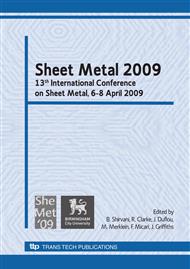p.3
p.15
p.25
p.37
p.43
p.53
Experimental Study of Lubrication Influence in the Production of Hydroformed T-Joint Tubes
Abstract:
THF process is a forming technique that consists of tube deformation by means of hydraulic pressure and punches which guarantee the tube ends feeding and sealing. In the last years, this technique found a large and rapid diffusion thanks to its many advantages with respect to conventional processes: parts weight reduction, tighter dimensional tolerances, lower costs or fewer secondary assembly operations. Besides, many lacks in the process knowledge still represent an obstacle and they are usually bypassed by trial and error methods. Therefore, lot of studies were conducted to better understand the influence of the process parameters, such as pressure path, punch stroke or material behaviour. In this paper, an experimental study of tubular T-joints made of copper manufactured by means of THF process is described. The aim of this work is to analyze the tube-die interface friction condition effects on the final part. In fact, material flow during the process is greatly influenced by the friction conditions between tube and die especially due to the high pressure acting inside the tube. Different lubrication types were considered: dry, oil, Teflon, Teflon with oil, Teflon spray and Graphitic oil. Two different experimental campaigns were performed in this investigation. The first one was carried out in order to estimate the lubricant friction coefficients using a Pin on Disk tribometer. The second one was performed to study the effects of the lubrication on the process and the tests were conducted hydroforming T-joints under the different lubrication conditions considered. The collected data allowed to identify how the different lubrication conditions affect the final workpiece geometry. Moreover, a critical aspect of the process related to the tube wrinkling was identified and a solution was proposed.
Info:
Periodical:
Pages:
15-24
Citation:
Online since:
March 2009
Keywords:
Price:
Сopyright:
© 2009 Trans Tech Publications Ltd. All Rights Reserved
Share:
Citation:


